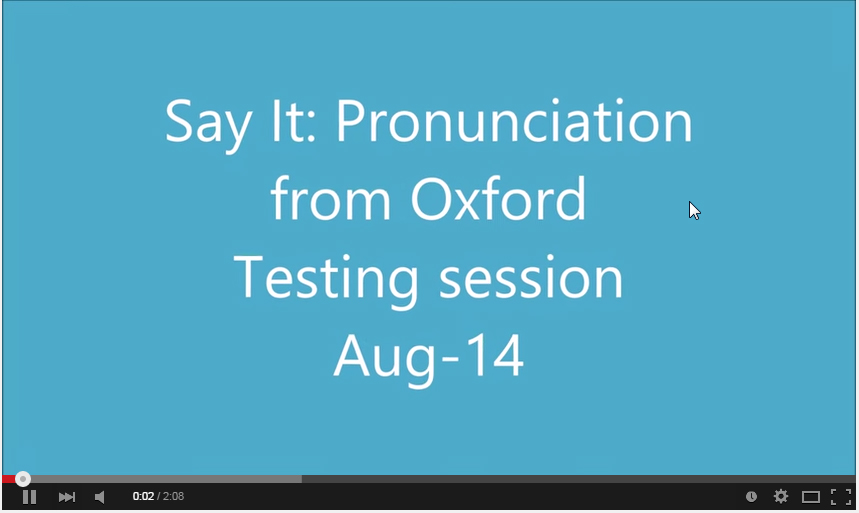 Jenny Dance, who runs a language school in Bristol, UK, tells us why pronunciation training is so important for her students and what led her to find a system that would allow them to practice more effectively.
Jenny Dance, who runs a language school in Bristol, UK, tells us why pronunciation training is so important for her students and what led her to find a system that would allow them to practice more effectively.
Helping learners improve their English pronunciation is a challenge for all EFL teachers – native and non-native speakers alike. English has so many unusual spellings, borrowed words and unpredictable pronunciations that even the most dedicated learners and patient teachers can find it tough to make good progress in this area.
And yet in my experience, improving a learner’s pronunciation is one of the most effective ways of raising their overall level of English. In his ‘Pronunciation Matters’ blog (5-Jan-12), Robin Walker, pronunciation expert, comments that pronunciation training helps with fluency, confidence and listening skills – all of which are at the forefront of effective communications. He goes on to quote studies showing the impact poor pronunciation has on writing, reading, vocabulary acquisition and grammar.
I wanted my students to be able to make the most of the English they had already worked hard to acquire. They may have been able to understand the word ‘comprehensibility’, and even write it with confidence – but I wanted to hear them using it fluently in their speaking, too. Improving pronunciation is, in a way, getting more ‘value for money’ from the words and phrases already learned.
It was also important to develop a more robust and objective system for helping learners assess, practice and improve their pronunciation. I felt students would benefit from seeing and having controlled access to the sounds they were producing. And with the rise of the touch screen and hand-held personal computers, I could see there was a big opportunity to enhance the way teachers and students approached pronunciation training.
Misplaced stress in a word can render it far less intelligible than an incorrect vowel sound. We aim to remedy the high frequency, high impact errors to help learners improve quickly. So with the help and feedback of a number of my students, we worked with Oxford University Press to develop Say It: Pronunciation from Oxford. The concept is simple: listen to the model sound (30,000 words, taken from the Oxford Dictionaries), record yourself, compare yourself and re-record until you’re happy you have made a good match to the model.
Using Say It in the classroom, either one-to-one or with a small group of students is a highly effective way to work on pronunciation skills. The teacher doesn’t need to listen and correct in real time – instead, you can review and discuss the sounds together, creating a real sense of partnership in the learning process. Because the assessment is clear and objective (for example, you can compare the stress placement at a glance), both teachers and students can understand the changes required to improve. Often, students are able to correct themselves to a large degree, which is a much more powerful learning experience.
Recent research shows that pronunciation is learned at a cognitive level (Gilakjani et al, 2011), in much the same way as a tennis player will visualise hitting the baseline rather than think about all the physical, mechanical elements required to execute the perfect tennis stroke. Say It seems to produce a cognitive response, with users responding quickly to the visual signposting of key features: stress placement and syllable structure. The soundwave and visual indicators give the student the ‘access points’ to the sound they need to produce.
Using Say It, learners can visualise, touch, listen to, dissect and perfect their pronunciation. It’s a quick, fun and effective way to practise and learn. For my students, pronunciation training is not about sounding like a native speaker, but rather being confident that you’ll be understood. As Camille, an FCE student told me about her experience using Say It: ‘Now, when I get on the bus and ask for a ‘single’ ticket, the driver will understand me!’
You can find out more about the Say It app for iOS here.
Reference
‘Why is pronunciation so difficult to learn?’ A. Gilakjani, S. Ahmadi and M. Ahmadi,
English Language Teaching 4 (3), 74.



Reblogged this on Halina's Thoughts and commented:
‘Pronunciation Matters’ blog (5-Jan-12), Robin Walker, pronunciation expert, comments that pronunciation training helps with fluency, confidence and listening skills – all of which are at the forefront of effective communications.
Thanks for sharing, Halina – glad you found the post interesting.
I agree that pronunciation is very important and I’ve tried a variety of resources (Sue Miller, Rachel’s English, English Central). But I’ve never had great success. I’ll certainly check your book, but I had a question: I’m sure you’ve had mixed results as well. With pronunciation, what would you say is the difference between students who succeed with and students who don’t?
Hi Stuart, thanks for your comment. I agree that it’s difficult to help students improve in this area, and I have also tried a number of pronunciation methodologies and techniques in the past. Students who are more willing to take risks, and those who can get the hang of listening actively tend to make quicker improvements to their speech sounds. I also think it’s important to help students understand that English spelling is no guide to pronunciation! Syllables, in particular, can be totally different than the spelling suggests. Finally, those who grasp the difference between strong and weak sounds will have a much better chance of creating a plausible sound-scape which will make them more easily understood. The Say It app is effective because it allows students to access and objectively analyse sounds (both the model and their pronunciation). I’ve seen students move from incomprehensible to comprehensible in the space of a couple of minutes using this app to help with particular problem words. The app is particularly effective when used with the guidance of a teacher.
I didn’t try a specific application to improve my students pronunciation. However, we use audio resources of our coursebooks, storybooks and some news websites. The students who record and listen to themselves show great confidence while speaking in the lessons or exams. I teach English in Turkey, and Turkish language has a very different intonation from English. Most learners don’t have big difficulties to understand audio resources, their main problem is fluency. I’m interested in theater and have been acting for five years. While shaping a new character in our plays, the first thing we do is trying a new voice. When you find your character’s voice, you can build his inner world more easily. Pronunciation and intonation are important to improve a second character.
At least, I can say that it works on me. I have learned English in Turkey with Turkish teachers. But when I started to focus on pronunciation and fluency, I started to feel more relax while speaking in English.
As teachers, we should teach the ways to improve this second character. Making them use the correct intonation and pronouncing the words well via drama, poetry and storytelling activities can be a nice start to develop second character.
Hello Englishinlife – I couldn’t agree more! I tell my more advanced students to try to identify a new persona, their ‘English self’, who speaks with English intonation, voice tone etc. I think this goes back to the point Robin Walker made about the level of interplay between reading, writing, speaking, listening, grammar and pronunciation. Thanks for posting, very interesting comment.
Reblogged this on M Amin Gental.